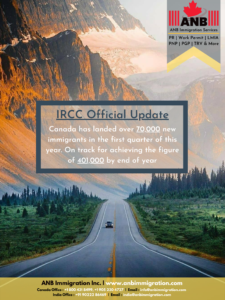Canada’s Absolutely On Track To Welcome 401,000 Immigrants This Year
IRCC’s March data shows Canada has landed over 70,000 new immigrants in the first quarter of this year.

Canada landed 22,425 new permanent residents in March 2021.
Data released by Immigration, Refugees and Citizenship Canada (IRCC) earlier this week shows that Canada welcomed over 70,000 new immigrants in the first quarter of this year. This Q1 2021 figure is a whopping almost double of the regular 35,000 mark which Canada had been landing per quarter since the start of the pandemic last year.
IRCC is guided by the most ambitious immigration plan in the country’s history. In late October 2020, the department’s minister, Marco Mendicino, announced the 2021-2023 Immigration Levels Plan as per which Canada aims to welcome 401,000 new immigrants in 2021. This number was last met in the historical year of 1913 and this year seems all set to repeat history. As the plans phase out into the next 2 years, the numbers are going to be even higher.
By way of comparison, Canada welcomed just 184,000 immigrants last year, due to coronavirus disruptions, which was well short of the 341,000 newcomers it welcomed in 2019. The rationale of the current levels plan is to welcome high levels of immigration to support Canada’s post-pandemic economic recovery. This recovery plan is going to need people of all skill sets to come in and help move the needle on the negative impact which the country has seen on the economy as has pretty much the rest of the world, thanks to the continued effects of the global Coronavirus crisis.
In light of its COVID-19 travel restrictions, Canada is prioritizing transitioning temporary residents to permanent residence during the pandemic. The main way IRCC is doing this is by holding Express Entry draws that target individuals currently in Canada. Express Entry is the primary way Canada welcomes economic class immigrants. The economic class accounts for nearly 60 per cent of the new immigrants Canada admits each year. Express Entry draws have targeted Provincial Nominee Program (PNP) and Canadian Experience Class (CEC) candidates. The CEC has comprised the overwhelming majority of successful Express Entry candidates in 2021.
On February 13, IRCC invited 27,332 CEC candidates to apply for permanent residence, which was almost six times larger than the previous Express Entry draw record. In addition, IRCC launched six new permanent residence streams last week that aim to transition some 90,000 essential workers and international graduates to permanent residence. The English-speaking international graduate stream reached its quota of 40,000 applicants in just over 25 hours.
The record-level Express Entry draws and these six new streams will provide IRCC with a significant tailwind by the third and fourth quarters of 2021 that will support its 401,000 targets. All of these numbers are in line with the post-pandemic recovery plan and also for Canada to strengthen the faith in its people about the fact that as a country it means business when it comes to supporting the population that has done so much for it thus far.
Many of those within Canada invited under Express Entry last year and the first half of this year will get their permanent resident status by the end of this year. In addition, IRCC has recently stated it aims to land at least 40,000 essential workers and graduates by year’s end.
Moreover, there is a significant seasonal component to Canadian immigration. Permanent residence landings tend to increase over the warmer spring and summer months. Despite travel restrictions, there remains the possibility that those allowed to immigrate to Canada will do so over the coming months when the weather is more favorable.
All in all, Canada is well-positioned to welcome the new era of post-pandemic recovery, thanks to all the efforts being put in by the whole system to recognize and award the hard work of the population that has stood by the country in thick and thin.
